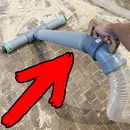Introduction: Roll-top Pannier From Duct Tape
Spring is slooowly starting to show its signs which means it is the perfect time to start preparing for the cycling season?! This ´ible will show you how to craft a roll-top pannier using only duct tape!
I am not going to tell a long story about how wonderful an invention duct tape is. If you have ever crafted or repaired anything you probably know it yourself. As Tape contest was taking place once again I finally decided to try out a project idea I had had for a long time. It was a waterproof pouch from duct tape.
The idea was inspired by the fact that here where I live it is quite hard to find completely waterproof and durable fabrics. As I still wanted to craft a pouch for hiking I came up with a solution - duct tape! Later on, I decided to make incorporate the pouch idea with a great passion of mine - cycling!
Check out the YouTube video I made to get a good overview of the build process. In the final step of 'ible you can find more photos of the finished pannier. If you have any questions or suggestions I encourage you to leave them down below for me to answer :)
If you appreciate my work and would like to see some more I invite you to subscribe on YouTube and follow me on Instagram! And if you find this ´ible worthy be sure to give it a vote in a contest ("vote now button" at the end of this page)! And go check out other cool tape related projects in the Tape contest!
Step 1: Tools and Materials
This project is really easy to build and requires a minimal amount of tools!
You will need:
- Cordless drill with drill bit
- Hot air gun (optional but highly recommended)
- Scissors
- Bolt tightening tools (screwdriver, wrench)
- Saw to cut hard backing material (jig saw, coping saw, band saw, etc.)
- Hacksaw and one zip tie (when you plan on adding the bungee cord)
Materials:
- Duct tape ( around 150 m - 3 rolls) I used two rolls of cheaper tape and one roll of higher quality (black) tape.
- Reflective tape ( optional)
- Two hooks ( I recommend ones with rubber coating)
- Small bolts M5, washers and locking nuts
- Bungee cord (50 cm) with hooks (optional)
- Hard backing (30x35 cm). Plastic, plywood etc.
- One Side release buckle
I found all these materials at my local hardware store. I spent a total of 30 euros on this project. It was probably a bit more than needed as I purchased one roll of tape too much and the bungee cord also came in a pack of two. Also, I think that these materials could be much cheaper when buying from online retailers. All in all, I would say that one pannier could be made with 20 euros or less.
Step 2: Making the Sides
In this step, I produced the "fabric".
I started by taping around 1.5 meter long strips on the table, making sure each new strip would overlap the previous one around 50%. When I had acquired the width I needed ( 20 cm) I flipped the whole thing over and added a second layer with the sticky sides facing each other. It really helps to tape the ends down so the whole thing does not move around so much.
I also added a third layer with the regular tape and decided to make the final, outer layer from a bit fancier black duct tape. I reckoned It was a bit higher quality and would last longer and of course, it looks cooler! After it was done I I used a hot air gun to improve the sticking of the tape. The aim is to heat the glue just a bit to make it stick better but not so much that the tape starts to melt. As you might know, duct tape comes in many colours - not just silver and black. Heck, you could give your pannier psychedelic hippie look if you wanted.
One suggestion I have for you when working with duct tape is to take it easy. This tape is a wonderful material when handled discretely but will give you much hassle when it starts to stick to itself. As you can see from the video and last photo I know what I am talking about. I messed up one half when peeling it off from the table.
Step 3: Connecting the Sides
When all sides are ready it is time to put together the basic pannier shape. As you can see I made the front and back side together and later cut them to right length which assured both had the same width.
Talking about the height of the pannier I recommend to leave it a little longer at first and trim it to the right size later. The wooden backing was 35 cm long and I added an extra 5 cm for the bottom and 25 cm for the top. 25 cm is enough for the roll-top closing method. Both front and back have to have the same length.
Next step is to connect al the sides. Lay the side piece next to the back side on a flat surface and start taping. First from the inside and then from the outside. Do this all the way around.
Next up attach the front face. This is a bit trickier as it can't really be laid on a table. Don't worry - the process will go fast once you get the hang of it.
Step 4: Roll-top and a Handle
The bag is now almost ready but is still missing something. Let's fix that!
Start by taking a piece of tape that is three times longer than the pannier is wide and fold it lengthwise on itself to form a band. Fold another two strips on the first one to make it a bit thicker and stronger. Fold it crosswise and add the female side of the buckle. Test the length by temporarily attaching the band to the pannier. Try rolling the mouth of the pannier shut and try out how far out the male side of the buckle should be to hold the rolled up pannier shut. It should hold the top firmly in place but not so tight that it starts to deform the shape of the pannier. Look at the photo to get a better picture of what I am talking about. When you have found the right length for the band tape it firmly to the top edge of the back side.
I also decided to add a little handle for when I am carrying the pannier by hand. This was made in a similar way as the previous "band", but both ends were left unfolded and were instead taped to the back of the pannier. Just be sure to actually measure that it is in the centre and don't do it like I did (by eye and not so centre)
Step 5: The Attching Mechanism
And the final step is to add hardware for attaching the pannier to your bike. I used two wall-mount hooks with rubber coating. I recommend using rubber coated hooks as they will not scratch your bike and rattle around when riding. I attached these hooks with four bolts making sure they were equal distance from the top. It took me at least six trips to the bike to get their location right. It was important that the pannier was as far behind as possible so my heel wouldn't hit it when pedalling. Also, I wanted to be able to attach the pannier on both right and left side of the bike rack. After finally finding the perfect location I bolted them down. I added a washer and locking nut on the inside. Make sure that the bolt is not protruding too much on the inside as it might damage whatever you are transporting. A bolt can be shortened with a hack saw, metafile or angle grinder.
And the final thing left to do was to add the elastic band to hold the pannier in place when riding over rougher terrain. This is optional but I highly recommend it just to make sure you would not get an unpleasant surprise by not finding your pannier where it is supposed to be after a long ride.
I removed both the hooks from the band and modified one of them slightly to get the shape seen in the photo. This was done with a hack saw by simply cutting the spiral shorter. The rubber band was also a bit too long so I shortened it and created a loop on the end with a zip tie. The other end already had this loop. Through these loops I attached the rubber band to the back of the pannier.
Step 6: The End
And that's it! Simple yet very satisfying project. I am not sure how long this pannier will hold up against weather but one thing is certain- if it should ever break or wear out there is an easy fix - another layer of tape! I would say that this pannier would not keep your stuff dry when you go scuba diving with it but it most certainly will do it on any bike ride no matter what is coming from the sky.
I realise that my explanations might not be crystal clear. Be sure to check out the build video and have a close look at the photos. And of course, I am more than happy to answer all the questions you can come up with regarding this project. Leave your thoughts down below!
If you appreciate my work and would like to see some more feel free to subscribe on YouTube and follow me on Instagram! And if you find this ´ible worthy be sure to give it a vote in a contest ("vote now button" at the end of this page)! And go check out other cool tape related projects in the Tape contest!
Have a wonderful day!
Andu

Third Prize in the
Tape Contest













